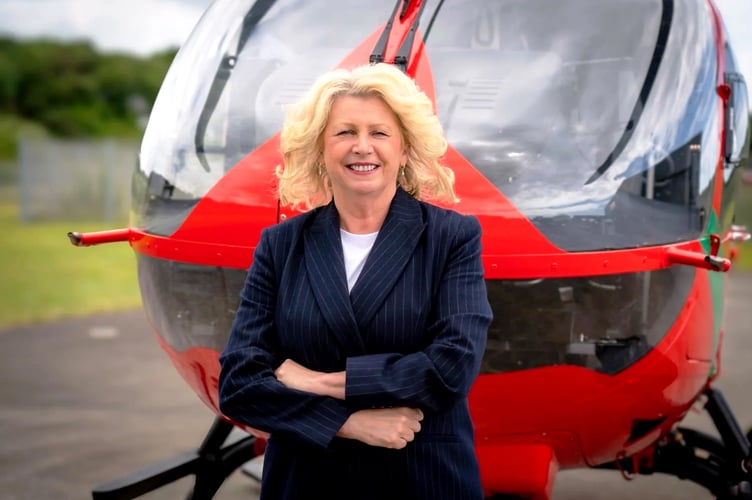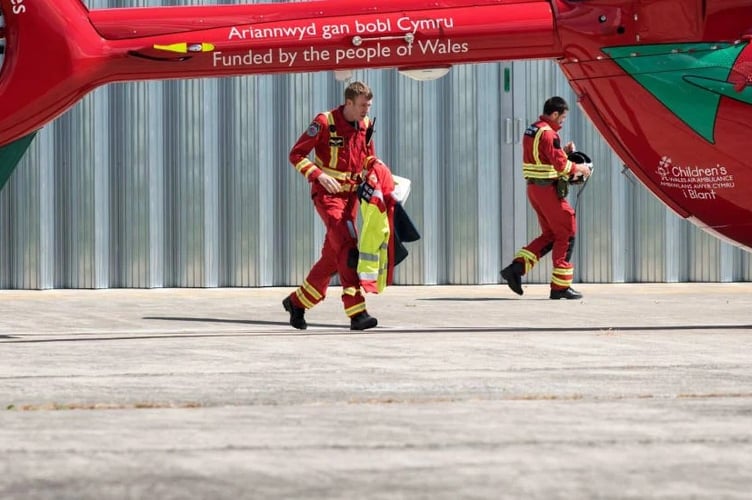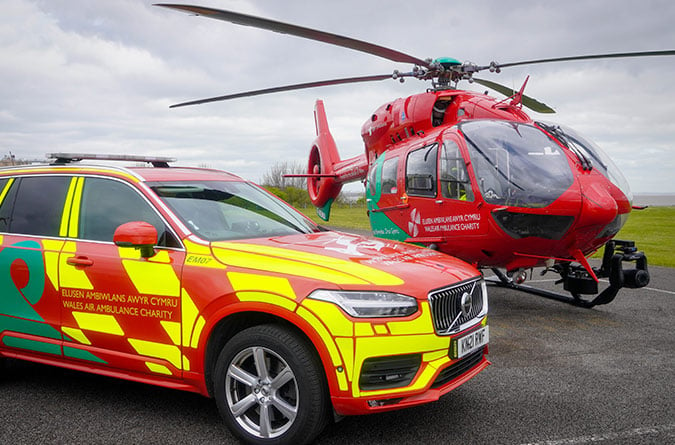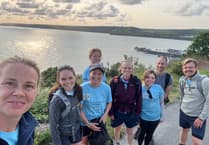So, a tractor overturns on a summer’s evening on in a field near Borth, pinning the driver beneath in a dangerous limb- or life-threatening position. Within moments, a 999 call goes out.
Police respond, so too several ambulances and firefighters from Aberystwyth. And the emergency crews on the ground call for a medivac helicopter from the Welsh Air Ambulance Service to respond. When the tractor driver is ‘extracted’ from underneath his machine, he’ll need to be airlifted to Cardiff for critical emergency care.
The Airbus H145 choppers are state of the art, with advanced features such as an integrated autopilot system and life-saving medical equipment that treats, stabilises, sustains or resuscitates patients. The aircraft can comfortably cruise at 140mph, covering the distance from Welshpool, the nearest current base, to the accident scene on this bright evening, in about 15 minutes. That’s scramble time, fight path determination, flying and searching for a safe landing zone already outlined by the emergency crews at the incident site.
As the chopper flies in a straight line, the distance is roughly 38 miles. By road, depending on the route, it’s 55 miles. That’s normally 92 minutes driving time for regular drivers. An specialised emergency response unit – the Welsh Air Ambulance now uses eight Volvo X90s to supplement the air cover – rushing on ‘blues and twos’ might be able to knock 15 minutes off that.
And it’s that difference in response times – 15 minutes compared to 77 – that’s the crucial point in the planned reorganisation and closure of helicopter services at Welshpool at Caernarfon.
The Wales Air Ambulance Charity has revealed that across 2023 and 2024, it was unable to attend 551 emergencies in North and Mid Wales between 8pm and 2am.
During this period, there were 632 life or limb-threatening emergencies in total but only 81 received a Wales Air Ambulance response. This is because the current service is not configured in the right way.
Dr Sue Barnes, Wales Air Ambulance Charity Chief Executive, said: “Each emergency involves at least one person in a life or limb-threatening situation, so these figures are both heartbreaking and unacceptable. That is why we are undertaking an improvement to our service that will provide us with more opportunities to save additional lives.”
The service is delivered via a unique third-sector and public-sector partnership. The charity relies on public donations to raise the £11.2 million required every year to keep the helicopters in the air and rapid response vehicles on the road.
Dr Barnes said: “Wales may have one of the most medically advanced air ambulances in the world but the current locations and operational hours mean we are not providing the best possible service with our current resources.”
Research has identified that the service is unable to get to between 2 to 3 patients a day. Yet, perversely, its bases in Caernarfon and Welshpool are significantly underused, the service says.
In addition, the service only has one aircraft that operates overnight, covering the whole of Wales between 7pm and 7am. This is based in Cardiff. There is no air ambulance provision overnight based in North or Mid Wales and these regions are reliant on the Cardiff crew being available and able to fly. At a regional level, over the two years of 2023 and 2024, the service missed 89 life or limb-threatening emergencies in Gwynedd between 8pm and 2am and 69 in mid Wales over the same period and times. It doesn’t provide breakdowns separately for Ceredigion and Powys.
The charity says that during the same period, there were 199 days when Wales Air Ambulance crews in Caernarfon did not see a patient. In Welshpool, it was 163 days without patient contact. Comparing this with the crews based in Dafen (28 days) and Cardiff (4 days), the charity says it’s clear to see the significant underuse of the service’s current resources in Caernarfon and Welshpool.
A deeply contentious independent review of the service, supported by medical and aviation experts and judicially approved in bitterly contested legal action, decided the current resources in Caernarfon and Welshpool should come together in one base location in a more central position of north Wales, near the A55. Two teams that can respond by road or air will operate from the new base. To meet the pattern of demand, one team will operate between 8am and 8pm and another team will operate between 2pm and 2am.
The service says of the main reasons for its underuse is due to their locations on the peripheries of north and mid Wales. “Their locations, and the poor road networks that surround them, make it more difficult for crews to effectively use the rapid response vehicles when the aircraft is unavailable,” it says.
And for opponents, that’s exactly the kernel of the matter. The roads are bad, the region is remote, access is difficult and the air crews are needed precisely because of that.
“During June, we received the disappointing news that our appeal against a decision that would have led to the closure of the Welshpool Air Ambulance base had failed after a judgement in the High Court,” the campaigners said in a statement issued this week. “This followed an application for Judicial Review that was issued last year, with a hearing which took place during January and February this year.”
The campaigners were responding to the lengthy explanation offered by Dr Barnes and the Air Ambulance service justifying its reorganisation.

“This was an incredibly disappointing outcome, but this may not be the end of the road in terms of challenging the decision.
“A further appeal has now been made and the Court of Appeal will decide whether to grant permission for that appeal to proceed.
“If permission is refused, this will bring an end to the case. If permission is granted, then the case will proceed to a hearing” the group said.
“From the outset we challenged the facts and reasons for change and questioned decision makers why they find it acceptable that 40 communities will receive a slower service and why it is reasonable to accept an increased unmet need in mid and north Wales.
“We believe that the proposals to close the Air Ambulance’s bases in Welshpool and Caernarfon were based on flawed information, and that the process has been filled with bias, misinformation, and misdirection.
“As part of the proposed changes, various ‘mitigation’ measures were announced, including additional road vehicles for areas of Mid and North Wales.
“Whilst we don’t think these measures are in any way sufficient, we will also be holding decision makers to account on their commitment that no bases would close until these additional road vehicles were in place.

“As a campaign group, we are continuing to pursue all avenues open to us to challenge the decision to close the two existing bases in Welshpool and Caernarfon” the group said.
Addressing concerns raised by opponents to the reorganisation in the areas near the current bases in Caernarfon and Welshpool, Dr Barnes said: “The passion from these regions towards Wales Air Ambulance is overwhelming and something we are incredibly grateful for.
“However, there have been many misconceptions about this development, which have resulted in concerns about a reduced service or even a loss of service,” she said.
“Rural areas are seeing important public services closing in their communities, and I completely understand how people have interpreted the reconfiguration of our service.
“I can wholeheartedly reassure you that this is not about losing or reducing a service; this is about improving what we already have – particularly for those in north and mid Wales. Our charity would never do anything to cause people, and their loved ones, future harm” she said.
From a medical perspective, Welshpool-based air ambulance medic Dr Stuart Gill said: “One of the most frustrating elements for us clinicians is knowing that there’s an emergency we can’t get to. Frequently, this happens with critically ill or injured patients in north and mid Wales.
“Through the planned service changes, we expect to significantly improve attendance for those people we are currently missing.”
Caernarfon-based air ambulance medic Dr Mark Knights added: “We have very expensive, highly capable resources, and we want them to be used as much as possible for the people who need them.
“The service improvement will allow us to reach more people and save more lives. We hope that the generosity of people across Wales will continue as it makes a lifesaving difference. Something we can vouch for.”
One of the questions asked about this service improvement focuses on response times. People near the current bases in Caernarfon and Welshpool have raised concerns about longer response times.
Addressing this, Dr Gill said: “It’s an understandable question and I want to offer our reassurance to those concerned. The answer to the question is focused on the way that the Wales Air Ambulance operates.
“Firstly, we are not a primary responder. Our colleagues at the Welsh Ambulance Service will attend the scene first. We are a secondary responder, bringing the hospital to the patient if needed.
“Secondly, we are a pan-Wales service, not a regional one.
“As clinicians, we travel the length and breadth of Wales to provide lifesaving critical care – regardless of where we are based. We are a scarce resource and will go wherever we are needed. Therefore, our response times are not measured in the same way as the ambulance service. Not everybody has an air ambulance based in their region but they still have access to our service when we are operational.
“Finally, we deliver hospital-standard treatments to the patient on scene. By doing this, we’re already saving significant time (hours in some cases) for a patient to receive emergency department care compared to a standard response where advanced treatment would not start until they arrive at a hospital.”
From the pilot’s perspective, Captain James Grenfell, from the Charity’s aviation partners Gama Aviation, spoke about how the service improvement will be a “game changer”.
James said: “We want to take the service to the next level in North and Mid Wales in a bid to save more lives, which is why we do what we do.”
Dr Barnes added: “Put simply, this service improvement will allow us to save more lives, particularly in mid and North Wales.
“We exist because of our supporters, and, with their continued support, our charity will be there for them and their communities – now and always,” she said.
But that “continued support” suggest by Dr Barnes can’t be taken for granted, given the depth of feelings on the ground over the reorganisation of the air service.
Emotional public meetings on the plans were held in towns across the region, with hundreds expressing fears that the level of new service simply won’t meet the needs to the rural communities, and that the helicopters were being moved to cover more populated areas where roads and emergency response times were better and quicker.
Teresa Morgan, from Llanwnnog near Caersws, spoke at one such meeting in Newtown about her experience of the work of the air ambulance - when her daughter suffered a blunt force injury.
"My daughter was airlifted quickly to hospital by the air ambulance, and it's because of the quick response that I have my daughter with me as she is today," she said.
"Her injuries could have been life changing, but because of the air ambulance and the quick treatment she received she's gone on to live a full and healthy life."
But back to that man trapped under the tractor near Borth.
Even under the new plans, a chopper from Dafen near Llanelli would cover the 83 direct miles in about 27 minutes after a scramble to the call, setting a path, flying and landing.
So, what does an extra 12 minutes trapped under a tractor feel like?





Comments
This article has no comments yet. Be the first to leave a comment.